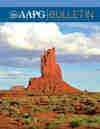Application of a deep-water stratigraphic framework to the production of the Wolfcampian units in the Permian Basin
IF 2.5
3区 地球科学
Q2 GEOSCIENCES, MULTIDISCIPLINARY
引用次数: 0
Abstract
To increase the understanding of the Wolfcampian unconventional plays within the Permian Basin, we present an integrated subsurface study shedding light on multiple target stratigraphic units (Wolfcamp A, B, C). We analyzed a rich data set covering 1000 km2 (386 mi2) in the deep-water sector (basinward of the shelf margin) of the Delaware Basin to generate a robust sequence stratigraphic framework that allows for the prediction of rock types and reservoir quality within specific sequences and improves the mapping of common-risk segments, the development options, and the landing zones in the most productive area of this super basin. These analyses consist of generating maps from seismic data and wells at basin scale (9300 km2 [35,900 mi2]), describing 29 cores, integrating 11 lithofacies and 15 petrofacies with core analyses (gamma ray, x-ray diffraction, total organic carbon, water saturation, porosity, permeability, Young’s modulus, Poisson’s ratio, compressional wave/shear wave), calibrating well log signatures to cores (gamma ray, density, neutron, resistivity), and assigning geological significance to log signatures (electrofacies). Results demonstrate how to create a simplified electrofacies model to identify the four main rock types of the basin. Interpretation includes determining time lines, correlating wells based on core analyses and calibrated log signatures, and propagating correlations to wells without cores.The stratigraphic framework, which evolved from the integration and reconciliation of multiple subsurface data sets (1) serves as a common starting point for new subsurface projects, (2) identifies the black siliceous mudstones as the best reservoir quality lithofacies and the lean dolomitic mudstone as the worst, and (3) classifies the stratigraphic beta unit as the most appropriate candidate for the development of unconventional resources.将深水地层框架应用于二叠纪盆地沃尔夫坎皮安单元的生产
为了加深对二叠纪盆地沃尔夫坎普非常规油气区的了解,我们开展了一项综合地下研究,揭示了多个目标地层单元(沃尔夫坎普 A、B、C)。我们分析了特拉华盆地深水区(大陆架边缘向下的盆地)1000 平方公里(386 平方英里)的丰富数据集,生成了一个强大的层序地层学框架,可以预测特定层序内的岩石类型和储层质量,并改进了这个超级盆地最富饶地区的共同风险区段、开发方案和着陆区的绘图。这些分析包括在盆地范围(9300 平方公里[35900 英里])内根据地震数据和油井生成地图,描述 29 个岩心,通过岩心分析(伽马射线、X 射线衍射、总有机碳、水饱和度、孔隙度、渗透率、杨氏硬度)整合 11 个岩性和 15 个岩层、孔隙度、渗透率、杨氏模量、泊松比、压缩波/剪切波),将测井记录特征与岩心(伽马射线、密度、中子、电阻率)进行校准,并赋予测井记录特征以地质意义(电岩相)。成果展示了如何创建简化的电成因模型,以确定盆地的四种主要岩石类型。解释工作包括确定时间线,根据岩心分析和校准测井特征对油井进行相关性分析,以及将相关性分析推广到没有岩心的油井。地层框架是在整合和协调多个地下数据集的基础上形成的:(1)可作为新地下项目的共同起点;(2)确定黑色硅质泥岩为储层质量最好的岩性,瘦白云质泥岩为储层质量最差的岩性;(3)将地层贝塔单元划分为开发非常规资源的最合适候选单元。
本文章由计算机程序翻译,如有差异,请以英文原文为准。
求助全文
约1分钟内获得全文
求助全文
来源期刊

AAPG Bulletin
工程技术-地球科学综合
CiteScore
6.60
自引率
11.40%
发文量
73
审稿时长
4.8 months
期刊介绍:
While the 21st-century AAPG Bulletin has undergone some changes since 1917, enlarging to 8 ½ x 11” size to incorporate more material and being published digitally as well as in print, it continues to adhere to the primary purpose of the organization, which is to advance the science of geology especially as it relates to petroleum, natural gas, other subsurface fluids, and mineral resources.
Delivered digitally or in print monthly to each AAPG Member as a part of membership dues, the AAPG Bulletin is one of the most respected, peer-reviewed technical journals in existence, with recent issues containing papers focused on such topics as the Middle East, channel detection, China, permeability, subseismic fault prediction, the U.S., and Africa.
 求助内容:
求助内容: 应助结果提醒方式:
应助结果提醒方式:


